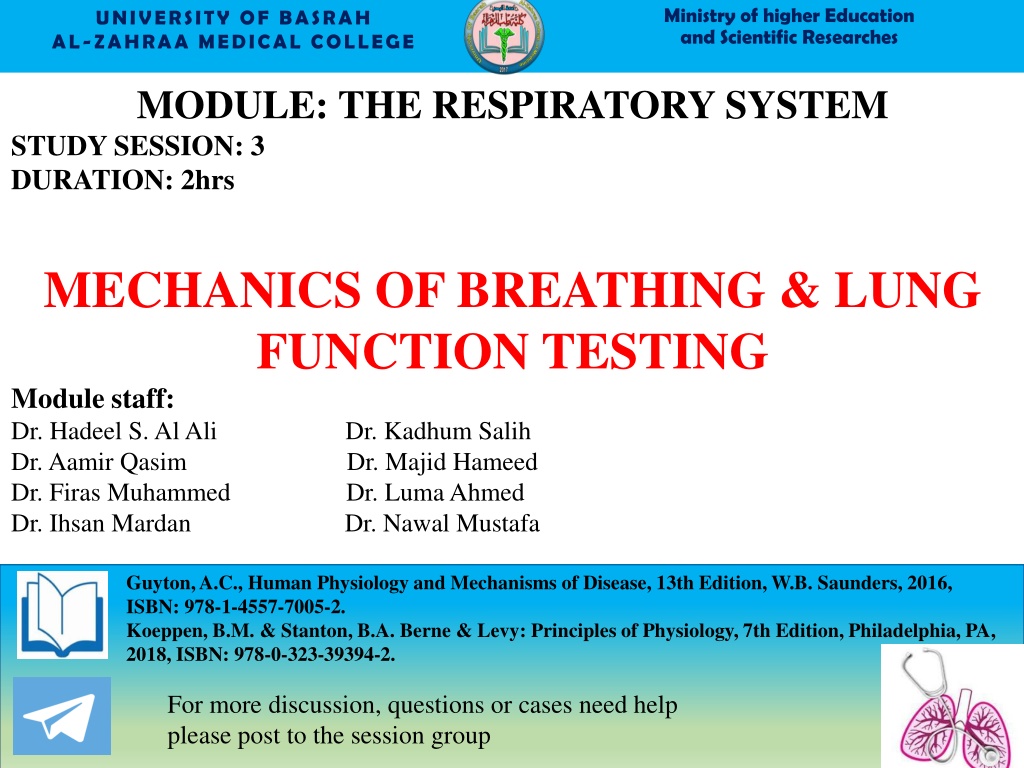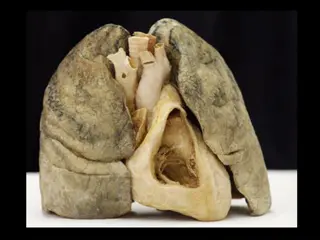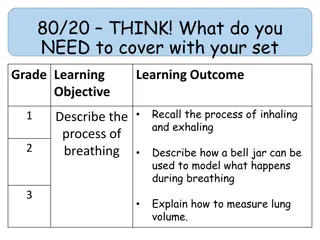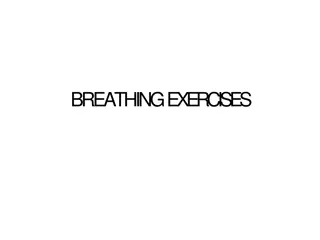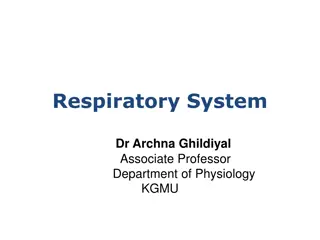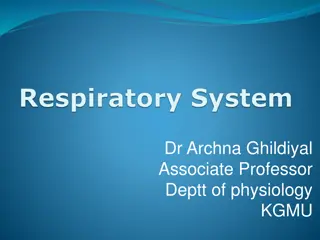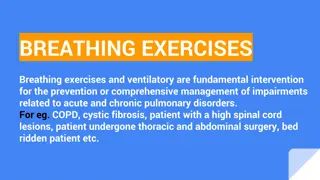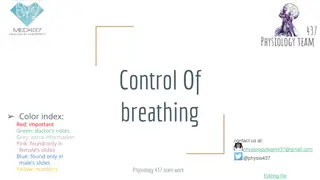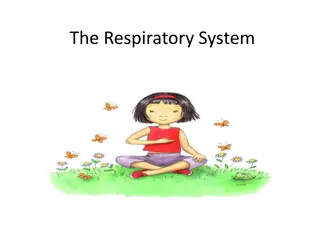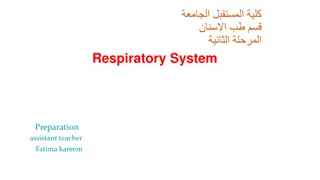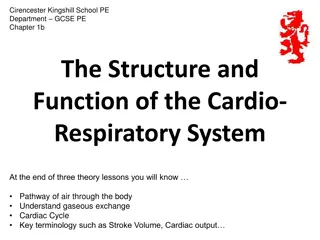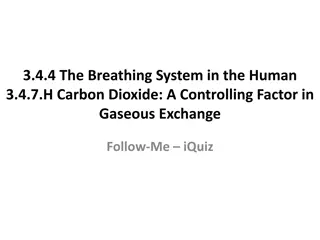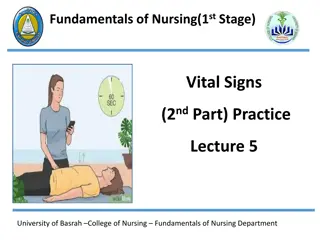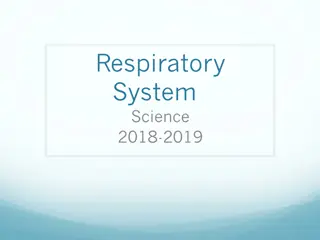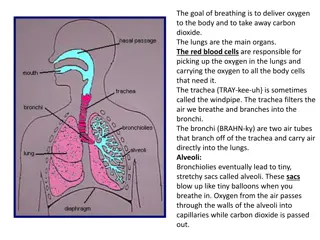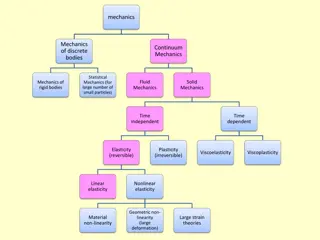Understanding Mechanics of Breathing in the Respiratory System
Explore the mechanics of breathing in the respiratory system, including pressure variations in inspiration and expiration, effects of introducing air into the pleural space, consequences of lung stiffness or compliance changes, conditions affecting lung stretchability, impact of small airway narrowing on functional residual capacity, and possible reasons for a lower Vital Capacity measurement in adults. Dive into key concepts and scenarios related to lung function testing.
Download Presentation

Please find below an Image/Link to download the presentation.
The content on the website is provided AS IS for your information and personal use only. It may not be sold, licensed, or shared on other websites without obtaining consent from the author. Download presentation by click this link. If you encounter any issues during the download, it is possible that the publisher has removed the file from their server.
E N D
Presentation Transcript
Ministry of higher Education and Scientific Researches UNIVERSITY OF BASRAH AL-ZAHRAA MEDICAL COLLEGE MODULE: THE RESPIRATORY SYSTEM STUDY SESSION: 3 DURATION: 2hrs MECHANICS OF BREATHING & LUNG FUNCTION TESTING Module staff: Dr. Hadeel S. Al Ali Dr. Kadhum Salih Dr. Aamir Qasim Dr. Majid Hameed Dr. Firas Muhammed Dr. Luma Ahmed Dr. Ihsan Mardan Dr. Nawal Mustafa Guyton, A.C., Human Physiology and Mechanisms of Disease, 13th Edition, W.B. Saunders, 2016, ISBN: 978-1-4557-7005-2. Koeppen, B.M. & Stanton, B.A. Berne & Levy: Principles of Physiology, 7th Edition, Philadelphia, PA, 2018, ISBN: 978-0-323-39394-2. For more discussion, questions or cases need help please post to the session group
MECHANICS OF BREATHING
6- Put the following pressures in rank order from highest to lowest during inspiration: pressure in the alveoli; pressure at the mouth; pressure in the pleural space. How will the above order change in 6.1. a quiet expiration to resting expiratory level? 6.2. a forced expiration?
7- What will happen to the lungs if air is introduced into a pleural space? What is this condition called? How might you treat it?
8- What will happen to the resting expiratory level (functional residual volume) if 8.1. the lungs become stiffer because of the development of fibrous tissue 8.2. the lungs become more compliant.
9- In what conditions will the lungs become easier to stretch?
10- What might happen to the Functional Residual Capacity if narrowing of the small airways makes it more difficult to force air through them when they are compressed during expiration? What effect will this change have on the shape of a patient s chest?
11- You measure an adult's Vital Capacity and find that it is only about half what you would expect for that individual. List some possible reasons for this. (Hint: Look at the tracing of lung volumes & capacities; what volumes add up to make the Vital Capacity? How these could factors be affected)
12- What will happen to the compliance of the lungs in Respiratory Distress Syndrome? Describe the movements of the chest wall in a baby with respiratory distress syndrome, and explain what you describe.
13- In the normal lung, where in the airways is the highest flow resistance 13.1. in peak inspiration? 13.2. During a forced expiration?
14- Why do we tend to breathe through our mouths in exercise?
MCQ T F 1 The lungs expand if removed from the body. [ ] [ ] 2 Air in the pleural space will reduce vital capacity. [ ] [ ] If the diaphragm contracts lung volume will increase. 3 [ ] [ ] In a forced expiration the diaphragm is driven into the thorax by contraction of the intercostal muscles. 4 [ ] [ ]
1 The compliance of the lung is the pressure change per unit [ ] volume change. [ ] Lung compliance is greater if the lungs are expanded nearly completely than if they are at low volume. 2 [ ] [ ] If the compliance of the lungs increases, pressure at any given lung volume, will be higher. 3 [ ] [ ] 4 Fibrosis of the lung decreases compliance. [ ] [ ]
1 Surfactant is secreted by type II alveolar cells. [ ] [ ] 2 Surface tension forces increase at high lung volumes [ ] [ ] The surface tension of the fluid lining the lungs at any given volume is greater when the lung is being 3 [ ] [ ] expanded than when it is recoiling. 4 Absence of surfactant reduces the number of alveoli in the lungs. [ ] [ ] 5 Absence of surfactant leads to greater inspiratory effort. [ ] [ ]
1 Air flow in the trachea is always laminar. [ ] [ ] The resistance to air flow through the bronchioles is greater in expiration than in inspiration. 2 [ ] [ ] The resistance to air flow would be increased by inhalation of a 2 adrenoreceptor agonist. 3 [ ] [ ] Partial occlusion of a large airway will reduce maximum flow in expiration. 4 [ ] [ ]
1- Sketch what will happen to the vitalograph trace of a patient with emphysema.
2- Sketch what will happen to the vitalograph trace of a patient with mild asthma
3- Sketch the expiratory flow volume loop for a patient with a tumour obstructing a main bronchus.
4- Sketch the expiratory flow volume loop for a patient with restrictive lung disease.
